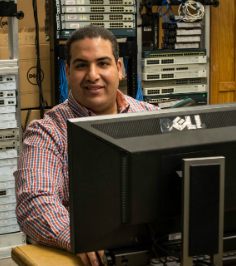Research Could Benefit Drivers in Traffic Congestion
NewsBy: Julie Stern
 Ask Dr. Samy El-Tawab about his research and his face will light up. Not only is he full of enthusiasm for what he does, he’s good at it too; his traffic incidents research was featured in publication alongside researchers from BMW Group Research and Toyota Research institute.
Ask Dr. Samy El-Tawab about his research and his face will light up. Not only is he full of enthusiasm for what he does, he’s good at it too; his traffic incidents research was featured in publication alongside researchers from BMW Group Research and Toyota Research institute.
Dr. El-Tawab, an assistant professor of Integrated Science and Technology at James Madison University, studies how information can be successfully exchanged between cars and the roadway. If implemented, the research could help drivers know about traffic congestion and incidents early in advance.
“Imagine a belt installed on the highway every couple of miles,” he explains in a podcast. “By exchanging information between the belt and highway you can collect [highly correlated] data from passing vehicles.”
The information is exchanged wirelessly. As a car drives over the belt, a radio-like mechanism in the car transmits a signal to the belt, which keeps track of data.
“Assume there is an incident,” Dr. El-Tawab continued. “Most cars naturally change lanes at a certain distance away from accident. Vehicles can detect that the lane change happens, and a system records it. The system, after a statistical amount of number of lane changes, will detect and report that an incident has occurred.”
The Intelligent Transport Systems society approached Dr. El-Tawab for the podcast interview after his research was featured in the IEEE (Institute of Electrical and Electronics Engineers) Intelligent Transport Systems Magazine this spring.
This architecture for notifying traffic incidents is called NOTICE. Dr. El-Tawab, with the help of four other researchers, began researching information exchange in NOTICE architecture as a continuation of research by Dr. Stephan Olariu and others at Old Dominion University in Norfolk, Virginia.
“Conducting the research can be dangerous,” said Dr. El-Tawab. “You can’t just walk out on the highway to collect data.”
While he is involved in other projects, Dr. El-Tawab says the successful information exchange of NOTICE architecture is “one of his favorites.”
He hopes that soon he will get approval from the Virginia Department of Transportation to test the research on a test bed.

